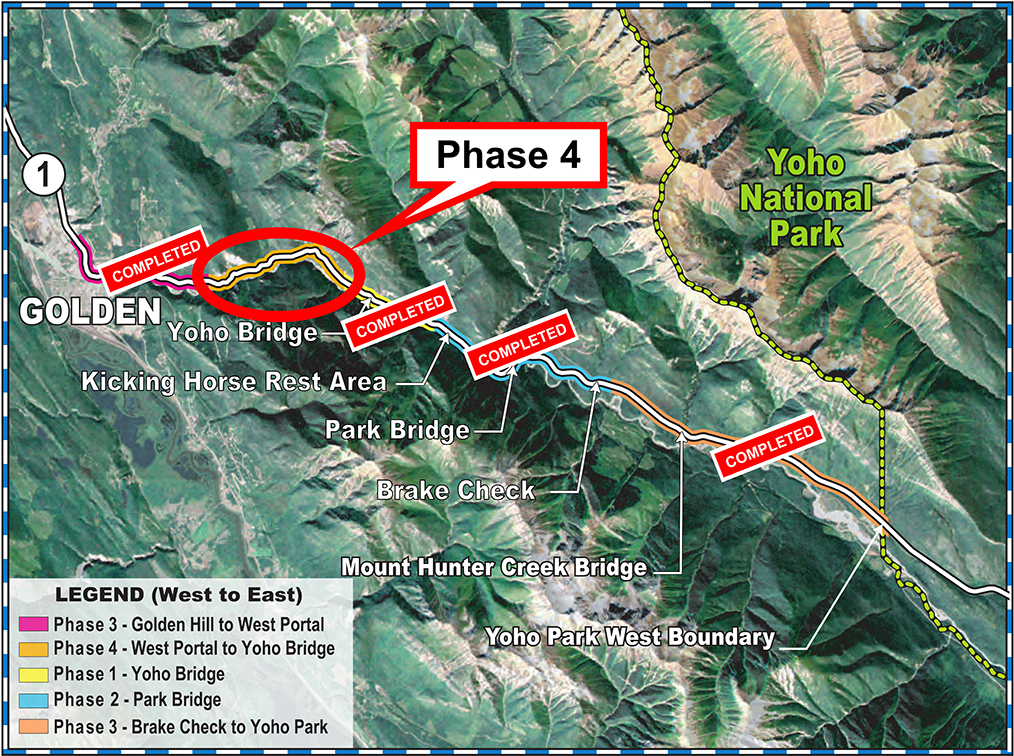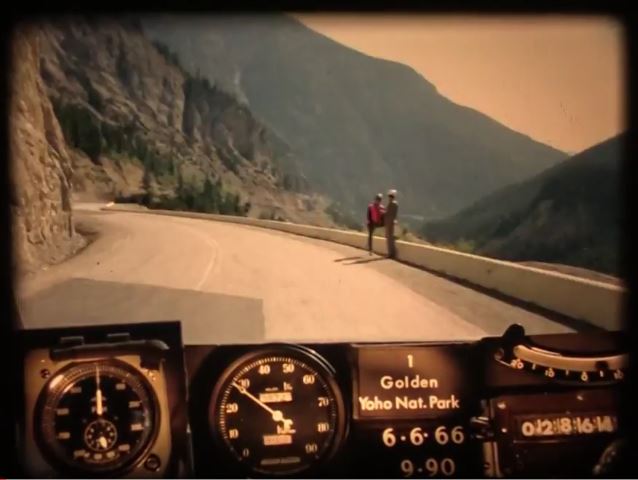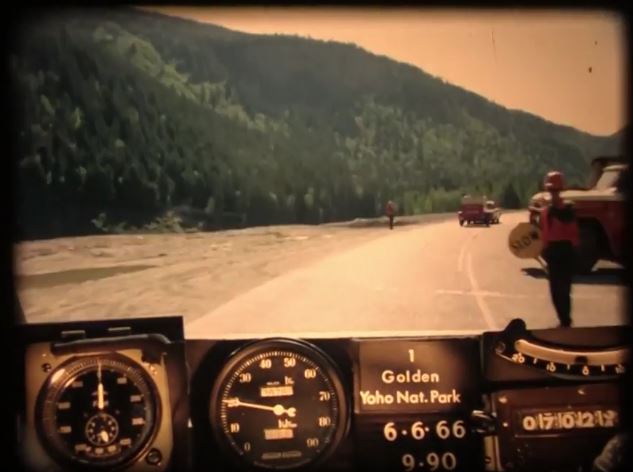
Rushing rivers and soaring mountains make for a beautiful road trip, but when it comes to widening and improving highways, those same breathtaking features can pose an incredible challenge. Few highways in BC are more beautiful or challenging than the Kicking Horse Canyon along Highway 1.
Constructed through Kicking Horse Pass in 1962 and following basically the original Canadian Pacific Rail route, this portion of the Trans-Canada Highway reaches its highest point at an elevation of 1,643 metres or 5,390 feet. That’s a pretty steep mountain. Add in the Kicking Horse River running alongside the road and you begin to see why this stretch has remained two lanes for so long. There was simply no room to grow without a large dollar value attached to it.
Work is now underway to tackle the most difficult and expensive phase of the Kicking Horse Canyon Project, from West Portal to Yoho Bridge. Construction costs are some of the most expensive in the province’s history per-kilometre and includes the four-laning and realignment of four kilometres of highway, requiring a combination of bridges, retaining walls, rock catchment ditches and other measures to reduce rock fall hazards and bring the road up to a modern four-lane standard.
We’ve fired up our Road Trip Time Machine to show you the road as it was in 1966 and to help you imagine where we are going on this important route in the future. Learn more about our photologs and see other BC Road Trip Time Machines here.

The Trans-Canada Highway is the primary east-west connector through British Columbia, our main gateway to the rest of Canada, and a vital route for travel, tourism and trade and BC Highway 1 (between Kamloops and the Alberta border) is being improved as a part of a 10 year transportation plan. Do you have any questions about this, or any other work we do? Let us know in the comments below or connect with us on Twitter or Facebook.
TranBC Trivia
Kicking Horse Pass and River were named after James Hector, a naturalist, geologist, and surgeon who was a member of the Palliser Expedition through the area in the mid 1800’s. Hector was kicked by his horse while exploring the region, knocked unconscious and believed dead. Luckily for Hector, he fully recovered but the horse story stuck and the area came to be known as Kicking Horse. Now you know.
Want to see more about the history of BC highways? Check out these links below:

I rember when my parents went up to Ashcroft to buy horses for their riding stables. that was 1939-1940 Ara it was called Norwood stables at the end of Norwood Ave then. they had an old Hudson and caribou hyway in those days was pretty scarrie.they had a 3 horse trailer and brought
back3 horses. there was afellow that had a Ranch and sold wild horses that were bucked through once a n d we had to gentle them when we got them home. his n ame was Jack Owen’he was part na indian.after that we paid to have him truck the rest we needed to us.i live in N Z now,but follow
what the Canadian govt is doing with much interest. my parents ran a riding stable during the war
years,their names were Graham and Iris Woods. both gone now
Thank you for sharing your memories with us.
Why not tunnel a new road which would allow the existing road to remain open?
Hi there – thanks for your question. When we plan projects, analyzing options is a critical part of our process. We evaluate the pros of those options against their technical difficulty and cost to build and maintain. If a design includes tunnels while achieving the objectives within the available budget, they might become part of the final solution. In this case, tunneling was ruled out due to costs and technical challenges. Hope this information is helpful.
yawn… .excuses, excuses, excuses. Interstate 70 freeway in Colorado was completed in 1963 with the highest point being the Eisenhower Tunnel at 3,400 m ( 11,100 ft). Much more challenging and it was done 60 years ago !
Hi there
I’d love to see preliminary design drawings. I looked around on your website but could not find any.
Is the new road cut into the steep slope like the existing one, or is it hung on the side of the cliff, or is it place over the river gorge?
A link to drawings / rendering / concept designs would be great.
Thank you!
Hello Jacob and thanks for your question. We have asked the KHC project team for artist renderings. In the meantime, here is a reference drawing:
https://www.kickinghorsecanyon.ca/app/uploads/sites/632/2020/10/khcp4-concept-plan.pdf
and a link to the KHC page: https://www.kickinghorsecanyon.ca/
what happened to the tunnel proposal
Hi Greg. While tunnels have been given some consideration in the past, the cost of both construction and long-term operation and maintenance of tunnels is very high. The ministry has determined that it is possible to build a facility that meets the objectives without tunnels. However, this will be a Design-Build contract in which the contractor will be expected to apply innovative ideas and approaches to meet or exceed the project objectives. Should a Design-Build contractor propose the use of a tunnel or tunnels in order to meet the project’s design and financial objectives, such a proposal would be fully evaluated on its overall merits.
I heard on the CBC Vancouver news report this morning to expect fall-time closures between Yoho and Golden in 2019. Are these closures posted anywhere?
Hi James. The project website it a great resource for information: http://kickinghorsecanyon.ca/
It includes material from two public information sessions held this week in Radium Hot Springs and Golden. These materials include a section on the project’s Traffic Management Strategy: https://www2.gov.bc.ca/gov/content/kicking-horse-canyon-project/kicking-horse-canyon-community/community-engagement
There have been media references to “extended full highway closures beginning next summer”. While early project work is expected to begin late next summer, as a result of significant public and stakeholder engagement, the traffic management plan being explored would apply the following principles:
– Avoiding closures and minimizing even brief stoppages during the daytime in the summer.
– Potential for extended 24-hour closures of up to 5-6 weeks in the spring shoulder season and up to 10-11 weeks in the fall shoulder season, with brief peak-hour breaks for local commuter traffic.
– Emphasis on night-time work, year-round. This is when shorter full closures might occur.
Apparently tunneling is not a consideration…? Why…?
Hello Fred,
There are no tunnels needed for the ministry’s reference concept as the project objectives are met with out them.
When we plan projects, analyzing options is a critical part of our process. We evaluate the pros of those options against their technical difficulty and cost. Tunnels are one of the solutions we considered during this process. You can look at the previous analysis in the 2008 preliminary design report posted on our public web site.
We hope that this helps!
Have got a link to previous analysis in the 2008 preliminary design report?
I would interested to see why a tunnel was ruled out
Hello Tim,
Thanks for your message. The Kicking Horse Canyon project website has a list of documents available for review: https://www.kickinghorsecanyon.ca/document-library/#planning
If you would like further information on any decisions made we encourage you to connect directly with project staff. The project website lists the ways in which you can do that here: https://www.kickinghorsecanyon.ca/contact/contact/
Hope that this is helpful.
I’m with Bryan Notheisz, so I have started a petition to try to motivate the politicians to get this done faster. If you travel this route please help us out by signing our petition at this link: http://chn.ge/2zAxqjd called “Mr Horgan and Prime Minister Trudeau: Make twinning the TransCanada Highway in BC a priority”.
I am wondering if there is any consideration given o the small herd of mountain sheep who are frequently seen at the western end of the construction area for this work?
Hi John,
Thanks for your question about the bighorn sheep that range around the Kicking Horse Canyon. I’m checking in with our project managers, and will get back to you here.
Hi John,
Thank you for your inquiry about Big Horn Sheep at the Kicking Horse Canyon Project – Phase 4. Like for the first three phases of the Kicking Horse Canyon Project, the project team is working with government agencies and stakeholder groups to minimize potential impacts to wildlife populations and habitats. We encourage you to explore our project website — http://www.kickinghorsecanyon.ca — for more information on wildlife studies, as well as the wildlife mitigation measures utilized in the first three phases of the Kicking Horse Canyon Project.
I am wondering if access to the Table Mountain trail will be included in the planning and building process?
Hi John,
We’ve sent your question to the project team. Stay tuned.
I’ve lived in Golden my whole life, often, the wail of ambulances keeps us up at night. I can’t imagine the nightmares of the first responders and families effected. I’ve been working with a type of excavator that hangs off a cliff on a cable, accessing extremely steep terrain. I’d like to speak with the project manger, there are many applications for this machine in a project like this that could reduce costs and significantly speed construction.
Hi Dale – please contact the Kicking Horse Canyon Project team here:
Office:
250 712-3629
Email:
KHC4.Finance@gov.bc.ca
Will this final section include any snowsheds?
Hello Rick,
The plan for phase four does not include any snowsheds. It does include multiple avalanche and debris flow walls. Here is the pdf of the plan: https://www.th.gov.bc.ca/kickinghorse/documents/KHCP%20Phase%204%20Four%20Laning%20Concept%20Plan%20Z9A-D.PDF
We hope that this helps. Please let us know if you have any other questions.
Though this is great news I sure wish that this whole project would be taken off the twenty year timeline and put on the five year one. I’m a BC’er transplanted to Alberta, my family lives in Chilliwack and my mother-in-law is in Vernon so we often return via Highway 1 and then Alberta 93 and 11 (we live in Drayton Valley). I hate the drive for the most part as there is just too much traffic and not enough four lane. Has there been any consideration to vastly upping the schedule and adding tolls, perhaps at a couple locations? I think that given the rewards there might actually be some acceptance for this option.
Hi Bryan,
Thanks for your comment. As you know from driving it – this is challenging piece of engineering to build. The current schedule is based on an expedited process called design-build. At present we don’t think it can be accelerated any further. There are presently no plans for tolling in this corridor. We hope that this helps!
Thanks for the reply. First, I have to say that I absolutely understand the challenges (geography, financial, local concerns, First Nations, Parks Canada) but it sure seems we’ve been planning this for a long time. A couple minutes on google found me this https://www.th.gov.bc.ca/kickinghorse/reports/5-1/comp_hwy_corridor_mgmt_plan.pdf which is a link to a study from 1996. I know improvements have been made but its slow. Frankly people die on this road on a regular basis. The Coquihalla was built in something like 18 months, if we keep on as we are it’ll be 20 before this is finally finished. Why not at least start doing some longer stretches on some of the less challenging sections? For example from Donald Bridge to the entrance to Glacier Park there are many kilometers that don’t appear to involve much blasting etc. Again, I completely understand it is a very challenging project but I truly believe we need to move it up a notch or two
Are there any plans to four-lane the stretch from Golden to Forde Stn. Rd.? I live in the Blaeberry and I find this stretch to be terribly dangerous with trucks and people illegally passing. Thanks for any insight!
Hello Carrie,
We shared your comment forward with the project manager who informed us that while there are no plans in the near future to four lane the stretch from Golden to Forde Stn. Rd., the ministry did announce a four-laning project last week between Donald and Forde Stn. Rd last week. Here is the link for more information on that announcement: https://news.gov.bc.ca/releases/2017TRAN0032-000346
Any prospect of snow sheds on avalanche paths? If not, will there be provision for having two way traffic on one side of the central median (I assume it will be a hard median) to reduce the time needed to reopen the highway after avalanches? In the past this section has had some prolonged closures after avalanche events – which I understand are due to the need to truck out the debris as it can’t simply be bailed over the side because of the CP railway tracks below.
Good questions Nick! We have sent them to the project manager and will let you know.
Hello again Nick,
We spoke with the project manager who informed us that there is a reference concept drawing on the public web site that shows the planned alignment and features (http://www.kickinghorsecanyon.ca/khc_phase-4.htm).
The alignment is designed to avoid the areas of avalanche hazard, and accommodate rock falls in catchment ditches, like those used on the east approach to the Park Bridge.
Hope that this helps!
Who will be the contractor for rock scaling, rock bottling, mesh work? When will the slope stabilization part start?
Hello Coyote,
At this time a contractor for rock scaling, rock bottling and mesh work has not been selected. A Request for Proposals will be issued in the coming months for proponents interested in this Design-Build opportunity that would see construction beginning in 2019. Hope that this helps!
Is there a website where the contractors awards the tender will be announced? And do you have a date chosen when the contract will be awarded?
Hi Jordan,
You can look on BC Bid for tender award announcements – unfortunately the date of announcement for tender awards is not set in stone. For a project of this size, we often prepare a news release announcing the award. Hope that this helps!
https://www.bcbid.gov.bc.ca/open.dll/welcome?language=En
Just heard on Global News that construction isn’t going to START until 2019.
I moved the o Golden in 1966 as a child and always thought the “Canyon” was a treacherous piece of road and I recall traffic traveling through there at 20mph or less, frustrating the locals and the truckers on the Highway. What I noticed in the time machine video is th lack of on coming traffic, as well, th video does not reflect the narrowness of the Highway nor can you get a sense of how steep the canyon walls are. The upgrade of this stretch of Highway is long over due. In 1975 I travelling th Trans Canada Hwy all the way to Nova Scotia and this stretch of road, closely followed by the Roger’s Pass were by far th worst stretch of Highway. I am curious to know what happened to the plan for builinding tunnels through the mountain for this piece of the Kicking Horse Canyon ?
Hi Kaye,
Thanks for connecting with us here and sharing your memories.Tunnels were a consideration in earlier design concepts, however, further engineering during the preliminary design phase found more cost effective solutions that did not require them.
I suppose better late than never. Give it another decade or three and you might get round to doing the accident prone sections of two lane highway either side of Revelstoke too.